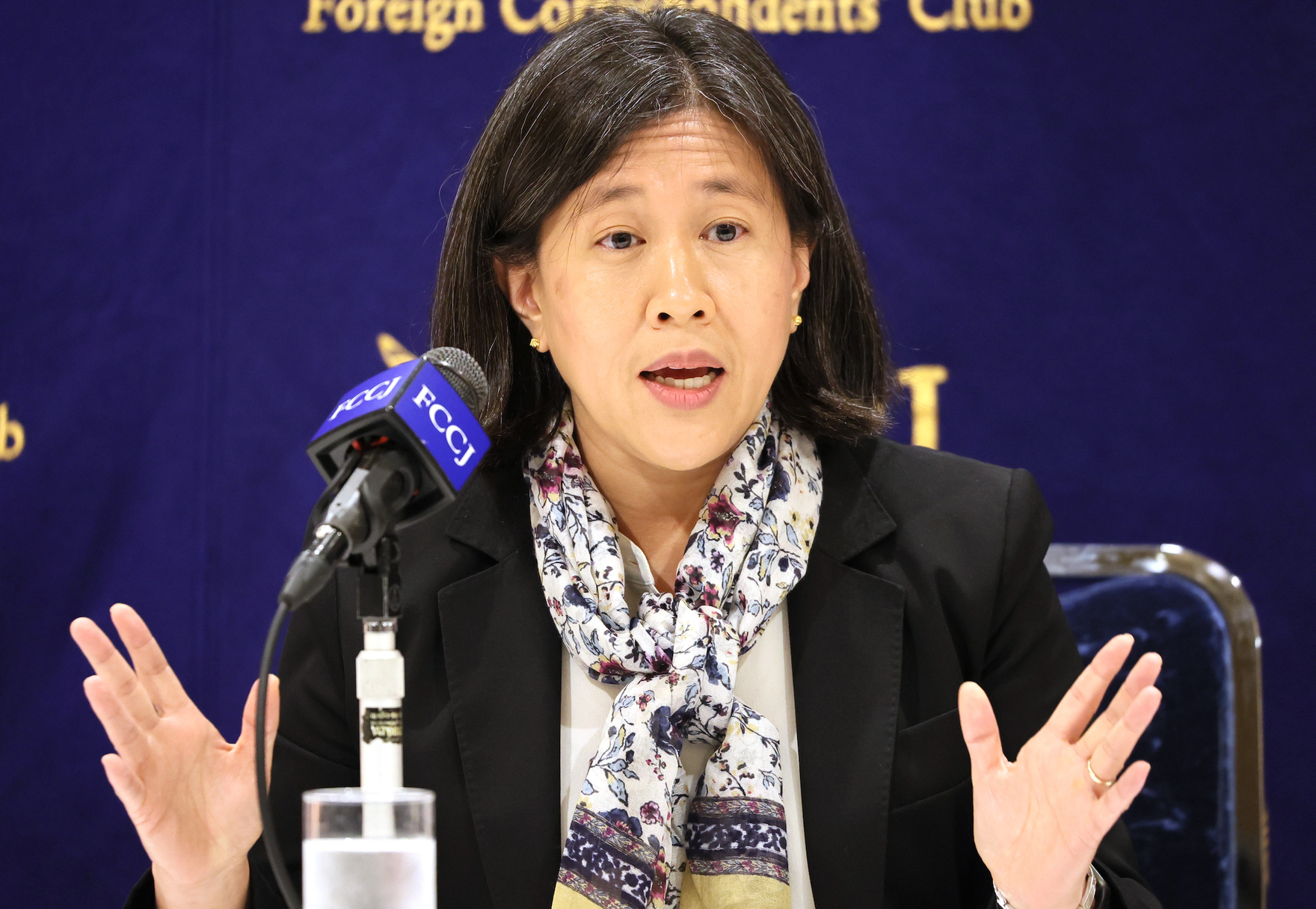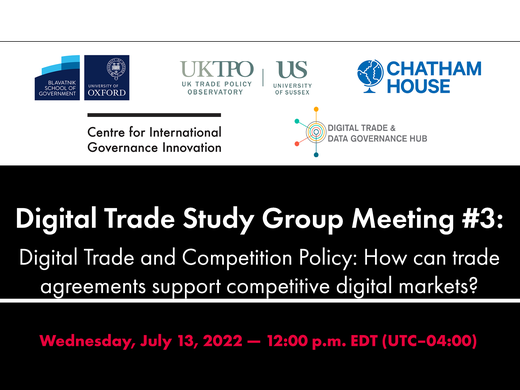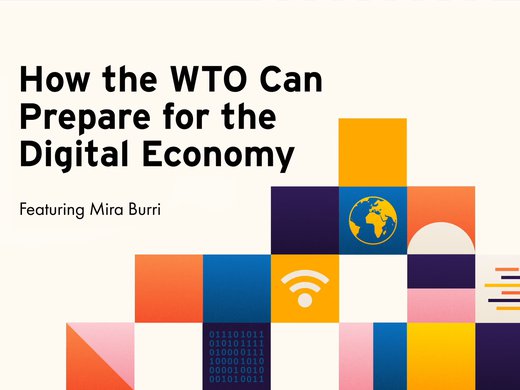Last week, all eyes were on Washington, DC, as the Biden administration introduced its new executive order on artificial intelligence (AI), aiming to address the challenges and risks associated with AI systems. Executive orders can be powerful, but their success often depends on how they are implemented. Fortunately, this sweeping order seems to have strong backing within the federal government, which suggests it stands a strong chance of influencing real change. In light of this, the Office of the United States Trade Representative’s (USTR’s) recent decision to adjust its stance on certain trade proposals, aimed at creating more room for policy makers, underscores the administration’s synchronized approach to technology and trade.
In a significant development in the continuing Joint Statement Initiative discussions on e-commerce at the World Trade Organization (WTO), the USTR recently announced that the United States is withdrawing its positions on certain far-reaching proposals concerning cross-border data flows, server location requirements, and trade secret protections for source code and algorithms. The move came as a surprise to many and raises numerous questions, the most obvious of which is this: How did the ambitious architect of digital trade rules get to this point of stepping back to provide policy space for Congress?
According to the USTR, this strategic move is aimed at creating ample “policy space” for the United States, along with other nations, to revisit and possibly recalibrate their digital trade strategies. It signals a more informed and deliberate approach to international digital trade talks, ensuring they align better with domestic and global digital policy objectives.
In tracing the roots of the move, it is essential to look back at the historical laissez-faire regulatory environment within which US tech companies have thrived. Until recently, they faced little to no regulation, both at home and abroad. This liberal stance enabled them to develop new services and introduce innovative technologies, often without considering societal implications such as privacy, surveillance, bias and discrimination, or inequality. In the quest for more clicks and greater engagement, they facilitated the spread of misinformation and disinformation. Over time, these tech companies’ business practices have helped them consolidate their power, monopolized markets, violated consumer rights, and often overlooked transparency and accountability.
The United States’ laissez-faire approach was further cemented by trade negotiators in recent agreements such as the Trans-Pacific Partnership Agreement (TPP), the United States-Mexico-Canada Agreement (USMCA) and the US-Japan Free Trade Agreement. These pacts aimed to dismantle so-called non-tariff trade barriers, which in this context may refer to regulations, privacy protections, anti-monopoly measures, consumer protection rules, as well as rules for fairness and non-discrimination. The result of far-reaching and enforceable trade rules was a status quo of minimal or no binding regulations for tech companies.
The US-Chile Free Trade Agreement in 2004 was the first free trade agreement (FTA) to include a dedicated e-commerce chapter, establishing a trend for all subsequent US FTAs. Initially, the scope and depth of commitments within these chapters were relatively limited. Over time, however, they have broadened to cover a wider range of issues.
The e-commerce chapter of the TPP, for example, while rooted in concepts similar to those presented in previous US trade agreements, included more ambitious and binding obligations. In the TPP, US trade negotiators formulated “gold standard” provisions on e-commerce, with the intent of restricting regulatory flexibility across various digital issues, covering topics from privacy to competition policy. Although the United States withdrew from the TPP post-signature, the remaining TPP parties (the so-called TPP-11) kept the e-commerce chapter, along with the US-crafted rules on e-commerce that tech companies strongly favoured and actively promoted.
After withdrawing from the TPP, the Trump administration advanced the TPP’s e-commerce discourse in the USMCA. The USMCA included a new e-commerce chapter, named “Digital Trade,” which retained similar TPP obligations but introduced additional obligations and a few exceptions to address public policy concerns. This presented a shift away from the e-commerce narrative, which carried echoes of the 1990s, toward a contemporary framework of digital trade poised to tackle digital protectionism. This was driven, in part, by the tech industry’s discontent with the “outdated” e-commerce narrative in the WTO, especially following their unsuccessful bid to secure a mandate for a new WTO agreement on e-commerce during the Eleventh WTO Ministerial Conference in Buenos Aires in 2017.
In fact, the challenges prevalent 10 years ago contrast starkly with those we face today. Social media, then considered mainly a platform for fun and connectivity, has today become a battleground for misinformation.
In fact, in the last decade, digital trade negotiations have emerged as crucial fora in which tech companies can counter regulatory pressures under the guise of fighting digital protectionism and promoting trade liberalization. The term “digital protectionism” played into their hands well: it’s an ambitious phrase that’s easy to invoke yet challenging to define. While many observers label China as a digital protectionist without hesitation, the narrative took a turn with the implementation of the European Union’s General Data Protection Regulation (GDPR) aimed at protecting privacy and safeguarding European data. Post-GDPR, numerous commentators have extended the tag of digital protectionism to Europe as well. This narrative found further traction in economic and political studies drawing parallels between the European Union and China concerning digital protectionism, attributing it to the regulations implemented and enforced in the European Union.
The language and structure of the US-crafted, tech-favoured TPP rules have made their way into other non-US bilateral and regional agreements, sometimes even maintaining the same footnotes originally crafted for the United States. These provisions quickly became de facto rules that trade negotiators not only incorporated into their agreements but also championed as their own, under the rationale of combatting digital protectionism and promoting a digital economy. While these trade negotiators have been criticized for neglecting meaningful consultations with domestic stakeholders, it is also suggested that they have often skirted collaboration with their national parliaments and domestic authorities on issues such as privacy, competition, consumer protection, labour, Indigenous rights and telecommunications. This oversight has led to the inadvertent creation of regulation-free zones in countries that are party to these agreements, significantly favouring tech companies at the expense of their own economy, labour force, privacy and domestic markets.
Recently, as more countries began contemplating tech regulation, this dynamic, shaped by digital trade rules, started to impede efforts to curb big tech’s monopoly power and address abuses such as data misuse, anti-competitive practices, the spread of misinformation and disinformation, privacy violations, consumer exploitation, market monopolization, bias and discrimination, as well as surveillance practices.
The USTR rationalized its recent decision to withdraw long-standing US proposals from the WTO talks that limit the regulatory policy space in the United States, aiming to provide Congress with ample space to regulate big tech companies. The USTR’s decision underscores the importance of revisiting these proposals, crafted in a different digital era, to ensure they align with worker-centric trade policy and the Biden administration’s priorities on competition, privacy and AI. This fresh approach not only underscores the need to effectively regulate big tech but also ensures that such a stance is consistently promoted and realized across all trade negotiations.
These US proposals can trace their origins back to the TPP. While the negotiations wrapped up in 2015, discussions among the remaining parties (TPP-11) continued after the Trump administration’s withdrawal from the TPP. The e-commerce chapter was not among the controversial chapters, such as intellectual property, market access or investment, that delayed the TPP’s conclusion or TPP-11 talks. Unlike other chapters, it never leaked, making it challenging to pinpoint the exact timeline for these proposals and when they were first introduced. Similar provisions appeared in the 2014 leak of the e-commerce chapter of the Trade in Services Agreement, a now-forgotten plurilateral trade agreement addressing services. Tracing back, these provisions began taking shape nearly a decade ago. Recognizing this timeline underscores the monumental changes our world has experienced over the past 10 years. The world looked quite different at that time. The discussions and decisions made by TPP negotiators then seem reflective of a distinctly different era.
In fact, the challenges prevalent 10 years ago contrast starkly with those we face today. Social media, then considered mainly a platform for fun and connectivity, has today become a battleground for misinformation. The gig economy was hailed for its potential yet now faces scrutiny for its labour practices. Generative AI and technologies such as ChatGPT were not on the horizon, highlighting how the tech landscape has evolved. The trade rules crafted during that era, to maintain a regulatory status quo of zero to minimal regulation, are now badly outdated. Not only have regulations struggled to keep pace with rapid technological transformation, but they also effectively pre-empt the regulations we aim to introduce now and in the future to safeguard public interests. This underscores the necessity for a fresh, reflective approach to digital trade policy.
In prompt engineering, a simple yet effective suggestion for enhancing ChatGPT’s accuracy has been to “take a deep breath” and approach challenges step-by-step. This has proven to deliver more accurate outcomes, showcasing the value of a deliberate, paced approach. It’s a lesson that resonates, given the critical juncture at which US digital trade policy has arrived.
The time has come for US digital trade policy to be subjected to “a deep breath” — a step back to allow policy makers to take stock of the evolving digital landscape. This is the right moment for reflection, dialogue, and thorough discussions among law makers and various US agencies, including the Federal Trade Commission, the Consumer Financial Protection Bureau, the National Telecommunications and Information Administration, the Department of Labor and a broad spectrum of stakeholders. The trade conversation should be inclusive, extending beyond big tech companies to small businesses, creators, workers’ groups, consumers and digital rights advocates.
The USTR’s recent move symbolizes a broader shift toward a more reflective and inclusive approach to digital trade policy making — one conscious of rapid technological evolution and its broader societal implications. A step-by-step, open and reflective approach will provide an opportunity to craft a more thoughtful and robust digital trade policy. The United States badly needs an approach that will also boost Congress’s ability to safeguard public policy, foster market competition, regulate AI and protect people’s privacy and rights. It’s a step, one hopes, toward a more resilient and just digital society.



